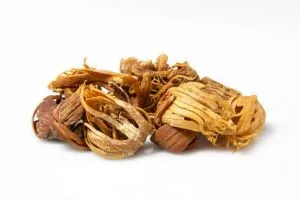One noteworthy spice that is much lesser-known than everyday parsley, sage, rosemary and thyme is mace. However, due to its potent nutritional benefits, it is definitely worth a place among your most prized kitchen spices.
Mace spice is actually derived from the red coverings of nutmeg seeds. These seeds grow on the nutmeg tree (Myristica fragrans), which is native to the Maluku Islands (aka Spice Islands) of Indonesia. Each nutmeg seed is coated with red bands that are waxy in texture, and it is these bands that are dried to produce mace spice.
This spice is used in many parts of the world to add flavor and aroma to various dishes. While somewhat similar to nutmeg, mace spice is more subtle, and also contains a peppery note. It is also nutritionally different from nutmeg, as it contains larger amounts of certain essential oils, as well as more vitamin A, vitamin C, calcium and iron.
Mace spice is quite high in both protein and fiber, making it a great spice for satiety and curbing cravings. It also contains the essential minerals copper, magnesium, manganese, potassium and zinc, as well as B-vitamins. Along with its vitamin and mineral content, this spice is rich in flavonoid antioxidants.
Celebrated for centuries for both culinary and medicinal properties, mace spice is traditionally employed for its digestion-stimulating properties, as well as for its function as an antidepressant and anti-fungal agent. It is also sometimes used in aphrodisiac concoctions. In Indian and Chinese traditions, mace spice is used for conditions of the digestive and nervous systems.
When mixed with a massage oil base (such as organic, extra virgin coconut oil) and applied topically, mace oil displays anti-inflammatory properties and can help to relieve sore muscles and joint pain. It also has a soothing and relaxing effect on both the body and mind. This oil also helps to stimulate circulation, and can ease indigestion and other forms of stomach discomfort when applied to the abdomen.

You can find this exotic and nutritious spice at health food stores. It is usually either sold in powdered form, or whole in “blades.” The blades are preferable, as you can grind them yourself to preserve both flavor and freshness. Choose organic whenever possible, and you will soon be elevating your recipes to a whole new level.
-The Alternative Daily
Sources:
http://recipeclout.india-server.com/mace.html
http://www.wisegeek.com/what-is-the-spice-called-mace.htm
http://www.nutrition-and-you.com/mace-spice.html
